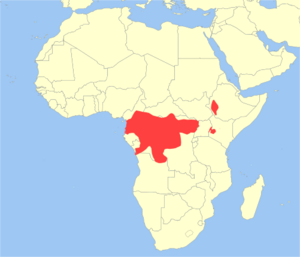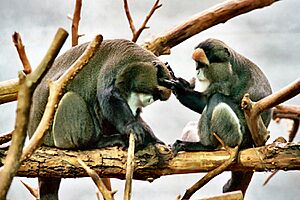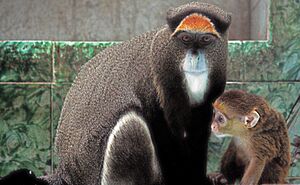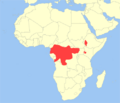De Brazza's monkey facts for kids
Quick facts for kids De Brazza's monkey |
|
|---|---|
 |
|
| Conservation status | |
| Scientific classification | |
| Genus: |
Cercopithecus
|
| Species: |
neglectus
|
 |
|
| Geographic range | |
The De Brazza's monkey (Cercopithecus neglectus) is a special type of monkey found in central Africa. It lives in forests near rivers and in swampy areas. This monkey is the largest in the guenon family. It is also one of the most common tree-dwelling monkeys in Africa.
You can tell a De Brazza's monkey apart from other monkeys by its bright orange forehead and white beard. These monkeys are very good at hiding. Because of this, scientists don't know everything about them. But they have learned some cool things, like how they sometimes stay with one partner. They can also be a bit aggressive towards other monkey species.
Contents
What's in a Name?
Locally, people sometimes call these monkeys "swamp monkeys." Their official name, De Brazza's monkey, comes from an Italian explorer. His name was Jacques Savorgnan de Brazza.
The scientific name for the species is neglectus. This word means "to pay no attention to." It was chosen because these monkeys are so good at hiding. They can easily stay hidden from both humans and predators.
How to Spot a De Brazza's Monkey
De Brazza's monkeys show a clear difference between males and females. This is called being sexually dimorphic. Males are bigger, weighing about 7 kilograms (15 pounds). Females are smaller, weighing around 4 kilograms (9 pounds).
Adult monkeys have grey fur with a reddish-brown back. Their arms and legs are black, and their tail is also black. They have a white patch on their bottom. Both male and female monkeys have cheek pouches. They use these pouches to carry food while they search for more. Males have distinct blue skin in certain areas, while females have reddish skin around their rear.
Young monkeys look a bit different. They don't have the dark colors on their arms and legs like adults. But they do have the white stripes and red bottom. Baby monkeys are a uniform brown color with just a small beard.
A white muzzle and beard are key features. They also have an orange crescent shape on their forehead. White stripes on their thighs help tell them apart from other guenons. This unique look makes them easy to recognize.
Where They Live and What They Eat
Where De Brazza's Monkeys Live
De Brazza's monkeys live in many parts of central Africa. You can find them in countries like Angola, Cameroon, and Kenya. They live in swamps, bamboo forests, and dry mountain forests. They might even be in Tanzania, but this is not fully confirmed.
These monkeys almost always stay near water. They rarely go further than 1 kilometer (about half a mile) from a river. Sometimes, you can even see them swimming! They prefer thick forests and dense plants. They only go into more open areas to find food. They mostly live in trees, but they do come down to the ground to eat plants. Because they hide so well, it's hard to know exactly how many of them there are.
What De Brazza's Monkeys Eat
De Brazza's monkeys mostly eat plants that grow on the forest floor. They also enjoy fruits when they can find them. If their main foods are scarce, they will also eat insects and seeds.
Who Hunts De Brazza's Monkeys
Some animals hunt De Brazza's monkeys. These include the crowned eagle, leopards, and common chimpanzees. Humans also hunt them. Rarely, dogs and large pythons might hunt young De Brazza's monkeys.
When a predator is near, these monkeys have a clever trick. They curl up tightly against a tree trunk. They hide their orange forehead and white thigh stripes. Then, they wait silently for the predator to leave. They only move if the predator gets too close. Even then, they move very quietly and slowly to avoid being seen.
De Brazza's Monkey Behavior
De Brazza's monkeys are thought to live as long as other guenon monkeys. They can live up to 22 years in the wild. In zoos, they can live for 30 years. Because they are so good at hiding, it's hard to watch them in the wild.
Their groups are usually small, from 2 to 10 monkeys. In some parts of West Africa, like Gabon, small family groups have been seen. These groups include a male, a female, and their young. In East Africa, De Brazza's monkeys live in groups with one male and several females. Single males sometimes try to take over a group to get access to the females.
Male De Brazza's monkeys make loud booming sounds. They usually do this in the morning to mark their territory. They also use this call to gather their group if they get separated. If a predator attacks, males will make an alarm call. For example, if a crowned eagle attacks, males will bark loudly and even try to scare the eagle away.
Female monkeys also make alarm calls. They might growl at humans. Otherwise, their sounds are quiet croaks when they are eating or resting. Baby monkeys make shrill squeals if they get lost. Since these monkeys hide so well, sometimes hearing their calls is the only way to know they are nearby.
Unlike other guenons, De Brazza's monkeys don't usually hang out with other monkey species. They can be aggressive towards them. They only tolerate some types of monkeys that don't compete for the same food.
Reproduction and Life Cycle
Female De Brazza's monkeys can start having babies around 5 years old. Males become ready to reproduce closer to 6 years old. Most young males leave their family group before they are fully grown.
The main time for breeding is from February to March. But females can also have babies if there is a lot of food available. Pregnancy lasts about 5 to 6 months. A baby monkey stays very close to its mother for its first year. After that, it stops drinking its mother's milk. Females usually have one baby at a time. Twins are very rare. They usually have about a year between births.
Protecting De Brazza's Monkeys
The IUCN Red List says the De Brazza's monkey is a species of "least concern." This means they are not currently in great danger. However, they still face threats. The main problems are deforestation (forests being cut down) for logging and farming. Hunting for bushmeat is also a threat.
Many De Brazza's monkeys live in zoos in Europe and North America. The Association of Zoos and Aquariums (AZA) has a special plan for them. It's called a Species Survival Plan. This plan helps manage the monkeys in zoos. It's unusual because the species is not listed as vulnerable or endangered. But the AZA wants to help prevent them from becoming endangered in the future. More information is needed to fully understand what these monkeys need to stay safe.
Images for kids








